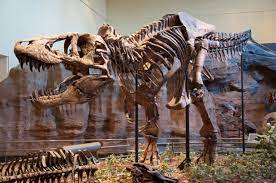The field of paleontology stands as a testament to humanity’s quest to unravel the mysteries of our planet’s ancient past. Every fossil unearthed tells a story, offering a glimpse into bygone eras and the creatures that once roamed the Earth. Yet, beyond the awe-inspiring discoveries lies a meticulous process governed by scientific rigor—one where correct names hold paramount importance. In the realm of paleontology, accurate nomenclature not only honors the contributions of early pioneers but also shapes the trajectory of scientific inquiry. This article delves into the significance of correct names in paleontology, drawing upon the intriguing tale of Megalonyx jeffersonii and the legacy of its namesake, Thomas Jefferson.
The Genesis of Megalonyx jeffersonii: In 1796, the unearthing of skeletal remains heralded a milestone in American paleontological history—the discovery of Megalonyx jeffersonii, a colossal ground sloth that once roamed North America. Named by Thomas Jefferson himself in 1799, this herbivorous behemoth became the first genus of fossil christened on American soil. Towering at nearly 10 feet tall and resembling a modern-day bear, Megalonyx captured the imagination of early naturalists and laid the foundation for the burgeoning field of paleontology.
Navigating Naming Conventions: Despite Jefferson’s meticulous observations and formal naming of the genus Megalonyx, subsequent publications cast a shadow of confusion over the correct spelling and attribution of the species. Loren Babcock, a professor of Earth sciences at The Ohio State University, embarked on a quest to untangle this taxonomic tangle. In his article published in the journal ZooKeys, Babcock underscores the importance of adhering to the original spelling and authorship of scientific names—a tribute to Jefferson’s pioneering efforts.
The Power of Precision: In the realm of paleontology, accuracy is paramount. Correct names serve as linchpins, anchoring scientific discourse and facilitating cross-disciplinary collaboration. Babcock’s advocacy for preserving Jefferson’s legacy underscores the broader significance of maintaining strict naming conventions. By honoring the original authorship and spelling, scientists ensure fidelity to historical records and pave the way for future discoveries.
Unraveling the Mysteries of Megalonyx jeffersonii: Beyond its taxonomic significance, Megalonyx jeffersonii embodies a rich tapestry of scientific inquiry and discovery. From early misconceptions about its carnivorous nature to its pivotal role in shaping paleontological reconstructions, this iconic ground sloth has left an indelible mark on the annals of science. Babcock’s research sheds light on the enduring legacy of Megalonyx jeffersonii and its enduring relevance in contemporary paleontology.
A Legacy Cast in Stone: As Megalonyx jeffersonii stands tall in the annals of paleontological history, its legacy serves as a testament to the power of correct names. From museum displays to digital media and popular culture, the iconic ground sloth continues to captivate imaginations and inspire future generations of scientists. Babcock’s stewardship of the Orton Geological Museum ensures that Jefferson’s monumental contribution to paleontology remains etched in stone, preserving the spirit of scientific inquiry for centuries to come.
In the ever-evolving landscape of paleontology, correct names serve as guiding beacons, illuminating the path of scientific discovery. Through meticulous scholarship and unwavering dedication, researchers like Loren Babcock uphold the integrity of scientific nomenclature, ensuring that the legacy of pioneers like Thomas Jefferson endures. As we journey through the annals of paleontological history, let us heed the lessons of the past and embrace the importance of accuracy in naming—the cornerstone of scientific inquiry and exploration.
